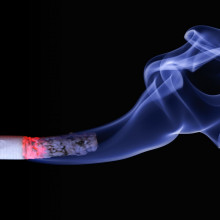Is second hand smoke more dangerous than smoking a cigarette?
Is it true that second hand smoking, or passive smoking, is more likely to give you cancer than smoking a cigarette? Tamsin Bell put this to Stefan Marciniak from the Cambridge Institute for Medical Research...
In this episode

00:00 - How harmful is second-hand smoke?
How harmful is second-hand smoke?
It's time for Question of the week. And this week Tamsin Bell’s been firing up on this question from Bethany.
Tamsin - In several countries around the world, new legislation means that smokers see a graphic health warning on cigarette packaging as constant reminder of potential side effects of smoking. But are the non-smokers at risk of these too?
We asked Stefan Marciniak, Professor of Respiratory Science at the University of Cambridge..
Stefan - This is a good question, and as with so many good questions the answer isn’t straightforward. It’s both yes and no.
Passive smoking, also called second hand smoking, is recognised by the World Health Organisation as a major global health problem. Every year nearly seven million people around the world will die from smoking-related illnesses. Six million of these are smokers - because half of all smokers will die of a smoking related disease such as cancer, heart attack, stroke or emphysema. But the remaining one million deaths are in non-smokers. That means that roughly 1 in 7 smoke-induced deaths is due to secondhand smoke!
Cigarette smoke contains more than 4000 different chemicals – of these we know for certain that at least 250 are toxic and at least 50 can cause cancer, such as arsenic, lead and cadmium. There is no safe limit to cigarette smoke exposure. Cigarette smoke comes in two forms: mainstream smoke (which is the smoke drawn in to the mouth of a smoker) and sidestream smoke (which is the smoke coming off the end of a smouldering cigarette). Second hand smoke is a mixture of exhaled mainstream smoke, mixed in with sidestream smoke. In a sense, it is true that side-stream smoke, often experience by bystanders, is “worse” because it contains much more carbon monoxide and other toxic chemicals, such as ammonia and nitrosamines compared to mainstream smoke because it hasn’t gone through the filter at the bottom of a cigarette. However, a passive smoker will be inhaling more dilute smoke compared to an actual smoker, so the smoker will still receive a larger dose of the toxins and in that sense the passive smoker isn’t actually coming off “worse”.
But we mustn’t underplay the dangers of passive smoking. Globally about a third of the deaths each year caused by secondhand smoke are in children. In the UK, passive smoking causes around 165,000 new cases of diseases in children each year, including asthma, pneumonia, and tragically, even sudden infant death syndrome. Even the unborn child is at risk -- pregnant women who are exposed to secondhand smoke are more likely to have low birth weight babies and these babies are more likely to be born prematurely.
This is why since October 2015 it has been an offence to smoke in a car with a child, and is also the reason smoking isn’t permitted in workplaces or social spots like bars and pubs.
So, to summarise, if possible, you should try and stay away from any type of cigarette smoke!
Tamsin - Thank you Stefan for such an informative answer, it really highlights the importance of not hanging out in the smoking area to look cool. Next time, we are sniffing out this more light-hearted question from Andrew:
“How do wombats produce cubed shaped droppings?”
Related Content
- Previous Catalysts: Our Tiny Chemists
- Next Fear on the Brain










Comments
Add a comment